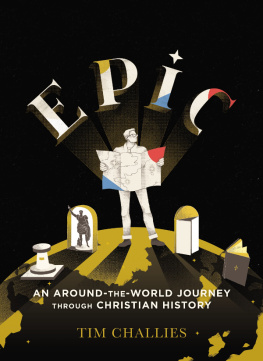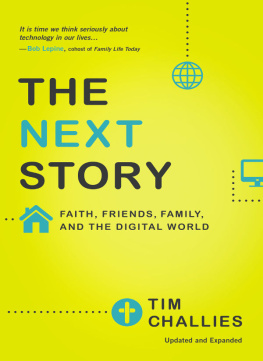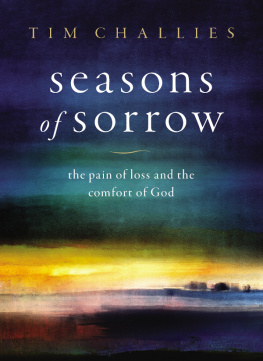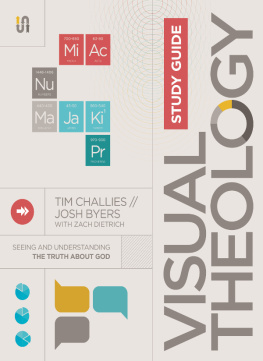Tim Challies - The Next Story: Life and Faith after the Digital Explosion
Here you can read online Tim Challies - The Next Story: Life and Faith after the Digital Explosion full text of the book (entire story) in english for free. Download pdf and epub, get meaning, cover and reviews about this ebook. year: 0, genre: Religion. Description of the work, (preface) as well as reviews are available. Best literature library LitArk.com created for fans of good reading and offers a wide selection of genres:
Romance novel
Science fiction
Adventure
Detective
Science
History
Home and family
Prose
Art
Politics
Computer
Non-fiction
Religion
Business
Children
Humor
Choose a favorite category and find really read worthwhile books. Enjoy immersion in the world of imagination, feel the emotions of the characters or learn something new for yourself, make an fascinating discovery.

- Book:The Next Story: Life and Faith after the Digital Explosion
- Author:
- Genre:
- Year:0
- Rating:4 / 5
- Favourites:Add to favourites
- Your mark:
- 80
- 1
- 2
- 3
- 4
- 5
The Next Story: Life and Faith after the Digital Explosion: summary, description and annotation
We offer to read an annotation, description, summary or preface (depends on what the author of the book "The Next Story: Life and Faith after the Digital Explosion" wrote himself). If you haven't found the necessary information about the book — write in the comments, we will try to find it.
The Next Story: Life and Faith after the Digital Explosion — read online for free the complete book (whole text) full work
Below is the text of the book, divided by pages. System saving the place of the last page read, allows you to conveniently read the book "The Next Story: Life and Faith after the Digital Explosion" online for free, without having to search again every time where you left off. Put a bookmark, and you can go to the page where you finished reading at any time.
Font size:
Interval:
Bookmark:
TIM CHALLIES
THE
LIFE AND FAITH AFTER
NEXT
THE DIGITAL EXPLOSION
STORY

For my brothers Pat, Andrew, Rick, and Justin
one by birth, three by marriage, all four in the Lord.
On October 30, 1961, the Soviet Union detonated the most powerful weapon ever created. Nicknamed Tsar Bomba, the king of bombs, it was a multistage thermonuclear warhead with explosive power in the range of 50 megatonsequivalent to detonating 50 million tons of TNT. This made it fourteen hundred times more powerful than the combined force of the nuclear bombs that the United States dropped on Hiroshima and Nagasaki in the closing days of the Second World War. In fact, the explosive force of this bomb alone was ten times greater than the total amount of explosives deployed in the entire war, including those two nuclear bombs.
It is hard for most of us to understand what 50 million tons of TNT would look like, so lets try this: Imagine that you had an Olympic-sized swimming pool full of it, packed from end to end, from top to bottom. Try to imagine the devastation you would bring about in igniting that quantity of one of the most powerful explosives in the world. What if you had ten of those pools full of it? Or a hundred? Or a thousand? 50 million tons is the equivalent of filling 11,000 Olympic-sized swimming pools with TNT and igniting it all simultaneously. And in Tsar Bomba all of that destructive power was contained in a single bomb that was 26 feet long and 6 feet in diameter.
Truly this was a weapon of unparalleled destruction.
At 11:32 a.m. the weapon detonated 13,000 feet above the surface of the Mityushikha Bay test range, on a Barents Sea island far above the Arctic Circle. The flash of light from the explosion was visible over 600 miles away, though it would take 49 minutes for the sound to reach that distance. The fireball reached from the ground to 34,000 feet in the air, and a person standing 60 miles away from the blast would have experienced third-degree burns from the heat. The mushroom cloud rose almost 40 miles into the sky, seven times higher than Mount Everest, and had a diameter of nearly 25 miles. Windows were shattered as far as 600 miles away. The shock wave, initially measuring 7.1 on the Richter Scale, was still measurable on its third passage around the circumference of the earth.
Some time after the detonation, a team was sent to ground zero, the epicenter of the explosion, to see the results. They reported, not surprisingly, that there had been utter devastation. The area of total and complete destruction was fully 44 miles in diameter.
Mityushikha Bay had been blown apart, but it had also been blown together, combined in new ways. You see, Tsar Bomba was a thermonuclear weapon, a hydrogen bombone that used nuclear fusion to cause devastation exponentially greater than anything that had previously been detonated. On a chemical level, much had been destroyedand much had been created. Out of the chaos of destruction a strange new order had emerged. Trees, plants, and animals had been blown to bits, reduced to their component parts. Hills had been leveled and valleys filled. What remained was a smooth and unnatural landscape both terrible and haunting. The rocks had not ceased to exist but had been reshaped, smoothed, and molded into new forms.
Mityushikha Bay was not gone; it was changed, altered forever.
Ten years after Tsar Bomba was detonated over Mityushikha Bay, another explosion occurred. Though it lacked the power and spectacle of Tsar Bomba, it has had a far greater impact on the world. In 1971, scientists at Intel Corporation introduced the Intel 4004, the worlds first commercially available microprocessor. The 4004 was the first and most rudimentary of what would eventually become a long line of processors that would find their way into nearly everything we own. As they shrank in size and increased in power, microprocessors were integrated into calculators, computers, televisions, mobile phones, automobiles, and toys. The invention of the microprocessor was a spark igniting the explosive growth of digital technology. Like Tsar Bomba, this digital explosion has reshaped the landscape of our lives, destroying and creating, splitting things apart and bringing them together in new ways.
Over the past three decades, digital technologies have powerfully changed our lives. They are woven into the very way we understand and relate to the world around us. We are now a digital culture. We are no longer who and what we were just a few decades ago.
Thanks to Jeff Patterson, Chris Roth, and Tom Gee for figuring out the math for me. Yes, it took three of them (one to do the work and the other two to correct him).
The DIGITAL EXPLOSION
This book began with a question. Actually, it began with an uneasy feeling that begged a whole series of heartfelt questions. I live as a writer and a web editor, spending most of my life sitting before a screen surrounded by the latest and greatest high-tech devices. And I began to feel overwhelmed. I began to feel as if maybe, just maybe, all of my devices, gizmos, and gadgets owned me as much as I owned them. Even worse, I came to see that these devices were constantly demanding my time and attention. They buzzed and beeped and blinked and called me to respond to them. Worse still, they quickly grew obsolete, falling out of favor and leading me to want newer, upgraded models.
All of this made me uneasy. I began to wonder: Am I giving up control of my life? Is it possible that these technologies are changing me? Am I becoming a tool of the very tools that are supposed to serve me?
I went searching for people who were asking similar questions, men and women who have taken time to think about what it means to live in a digital world, a world surrounded by gadgets, a world in which we define and understand ourselves in completely new ways. I found that there were others who have been asking these questionsdoctors, sociologists, theologians, technologists, philosophers. From some of them I learned how and why our gadgets have come to figure so prominently in our lives. Others provided helpful insight on how technology functions in human society. And from a precious few I began to learn how Christians can live in a digital world with virtue and dignity.
The digital revolution is global, reaching to the farthest corners of the earth. It affects the way we see, what we hear, how we interact with the world around us, and how we communicate with others. Swimming in this digital sea, we are caught up in a torrent of media, striving to stay afloat and make some headway against the rush of sounds, images, and words that seem intent on drowning us out. Some, like Rip Van Winkle, are just now waking up to this new reality. They rub their eyes and wonder what has happened. How has the world changed so quickly and so thoroughly? Others have been born into itthey are digital natives who have never known a world apart from digital technology.
As I read, reflected, and wrote, I found myself identifying with a little poem written by Danny Hillis, a technologist responsible for creating much of the computer architecture that lives within the machines we increasingly take for granted. Even Hillis, a computer genius and digital pioneer in his own right, knew that something profound had happened. He, too, wondered just how the digital explosion would reshape our cultural storyour understanding of ourselves and the world we live in.
Font size:
Interval:
Bookmark:
Similar books «The Next Story: Life and Faith after the Digital Explosion»
Look at similar books to The Next Story: Life and Faith after the Digital Explosion. We have selected literature similar in name and meaning in the hope of providing readers with more options to find new, interesting, not yet read works.
Discussion, reviews of the book The Next Story: Life and Faith after the Digital Explosion and just readers' own opinions. Leave your comments, write what you think about the work, its meaning or the main characters. Specify what exactly you liked and what you didn't like, and why you think so.







